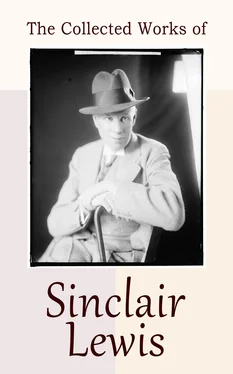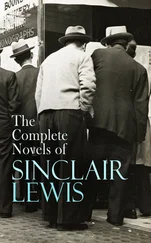“Now, Edgar, you read the next verse. What does it mean when it says it's easier for a camel to go through a needle's eye? What does this teach us? Clarence! Please don't wiggle so! If you had studied your lesson you wouldn't be so fidgety. Now, Earl, what is the lesson Jesus was trying to teach his disciples? The one thing I want you to especially remember, boys, is the words, 'With God all things are possible.' Just think of that always — Clarence, PLEASE pay attention — just say 'With God all things are possible' whenever you feel discouraged, and, Alec, will you read the next verse; if you'd pay attention you wouldn't lose your place!”
Drone — drone — drone — gigantic bees that boomed in a cavern of drowsiness —
Babbitt started from his open-eyed nap, thanked the teacher for “the privilege of listening to her splendid teaching,” and staggered on to the next circle.
After two weeks of this he had no suggestions whatever for the Reverend Dr. Drew.
Then he discovered a world of Sunday School journals, an enormous and busy domain of weeklies and monthlies which were as technical, as practical and forward-looking, as the real-estate columns or the shoe-trade magazines. He bought half a dozen of them at a religious book-shop and till after midnight he read them and admired.
He found many lucrative tips on “Focusing Appeals,” “Scouting for New Members,” and “Getting Prospects to Sign up with the Sunday School.” He particularly liked the word “prospects,” and he was moved by the rubric:
“The moral springs of the community's life lie deep in its Sunday Schools — its schools of religious instruction and inspiration. Neglect now means loss of spiritual vigor and moral power in years to come.... Facts like the above, followed by a straight-arm appeal, will reach folks who can never be laughed or jollied into doing their part.”
Babbitt admitted, “That's so. I used to skin out of the ole Sunday School at Catawba every chance I got, but same time, I wouldn't be where I am to-day, maybe, if it hadn't been for its training in — in moral power. And all about the Bible. (Great literature. Have to read some of it again, one of these days).”
How scientifically the Sunday School could be organized he learned from an article in the Westminster Adult Bible Class:
“The second vice-president looks after the fellowship of the class. She chooses a group to help her. These become ushers. Every one who comes gets a glad hand. No one goes away a stranger. One member of the group stands on the doorstep and invites passers-by to come in.”
Perhaps most of all Babbitt appreciated the remarks by William H. Ridgway in the Sunday School Times:
“If you have a Sunday School class without any pep and get-up-and-go in it, that is, without interest, that is uncertain in attendance, that acts like a fellow with the spring fever, let old Dr. Ridgway write you a prescription. Rx. Invite the Bunch for Supper.”
The Sunday School journals were as well rounded as they were practical. They neglected none of the arts. As to music the Sunday School Times advertised that C. Harold Lowden, “known to thousands through his sacred compositions,” had written a new masterpiece, “entitled 'Yearning for You.' The poem, by Harry D. Kerr, is one of the daintiest you could imagine and the music is indescribably beautiful. Critics are agreed that it will sweep the country. May be made into a charming sacred song by substituting the hymn words, 'I Heard the Voice of Jesus Say.'”
Even manual training was adequately considered. Babbitt noted an ingenious way of illustrating the resurrection of Jesus Christ:
“Model for Pupils to Make. Tomb with Rolling Door. — Use a square covered box turned upside down. Pull the cover forward a little to form a groove at the bottom. Cut a square door, also cut a circle of cardboard to more than cover the door. Cover the circular door and the tomb thickly with stiff mixture of sand, flour and water and let it dry. It was the heavy circular stone over the door the women found 'rolled away' on Easter morning. This is the story we are to 'Go-tell.'”
In their advertisements the Sunday School journals were thoroughly efficient. Babbitt was interested in a preparation which “takes the place of exercise for sedentary men by building up depleted nerve tissue, nourishing the brain and the digestive system.” He was edified to learn that the selling of Bibles was a hustling and strictly competitive industry, and as an expert on hygiene he was pleased by the Sanitary Communion Outfit Company's announcement of “an improved and satisfactory outfit throughout, including highly polished beautiful mahogany tray. This tray eliminates all noise, is lighter and more easily handled than others and is more in keeping with the furniture of the church than a tray of any other material.”
IV
He dropped the pile of Sunday School journals.
He pondered, “Now, there's a real he-world. Corking!
“Ashamed I haven't sat in more. Fellow that's an influence in the community — shame if he doesn't take part in a real virile hustling religion. Sort of Christianity Incorporated, you might say.
“But with all reverence.
“Some folks might claim these Sunday School fans are undignified and unspiritual and so on. Sure! Always some skunk to spring things like that! Knocking and sneering and tearing-down — so much easier than building up. But me, I certainly hand it to these magazines. They've brought ole George F. Babbitt into camp, and that's the answer to the critics!
“The more manly and practical a fellow is, the more he ought to lead the enterprising Christian life. Me for it! Cut out this carelessness and boozing and — Rone! Where the devil you been? This is a fine time o' night to be coming in!”
Table of Contents
I
There are but three or four old houses in Floral Heights, and in Floral Heights an old house is one which was built before 1880. The largest of these is the residence of William Washington Eathorne, president of the First State Bank.
The Eathorne Mansion preserves the memory of the “nice parts” of Zenith as they appeared from 1860 to 1900. It is a red brick immensity with gray sandstone lintels and a roof of slate in courses of red, green, and dyspeptic yellow. There are two anemic towers, one roofed with copper, the other crowned with castiron ferns. The porch is like an open tomb; it is supported by squat granite pillars above which hang frozen cascades of brick. At one side of the house is a huge stained-glass window in the shape of a keyhole.
But the house has an effect not at all humorous. It embodies the heavy dignity of those Victorian financiers who ruled the generation between the pioneers and the brisk “sales-engineers” and created a somber oligarchy by gaining control of banks, mills, land, railroads, mines. Out of the dozen contradictory Zeniths which together make up the true and complete Zenith, none is so powerful and enduring yet none so unfamiliar to the citizens as the small, still, dry, polite, cruel Zenith of the William Eathornes; and for that tiny hierarchy the other Zeniths unwittingly labor and insignificantly die.
Most of the castles of the testy Victorian tetrarchs are gone now or decayed into boarding-houses, but the Eathorne Mansion remains virtuous and aloof, reminiscent of London, Back Bay, Rittenhouse Square. Its marble steps are scrubbed daily, the brass plate is reverently polished, and the lace curtains are as prim and superior as William Washington Eathorne himself.
With a certain awe Babbitt and Chum Frink called on Eathorne for a meeting of the Sunday School Advisory Committee; with uneasy stillness they followed a uniformed maid through catacombs of reception-rooms to the library. It was as unmistakably the library of a solid old banker as Eathorne's side-whiskers were the side-whiskers of a solid old banker. The books were most of them Standard Sets, with the correct and traditional touch of dim blue, dim gold, and glossy calf-skin. The fire was exactly correct and traditional; a small, quiet, steady fire, reflected by polished fire-irons. The oak desk was dark and old and altogether perfect; the chairs were gently supercilious.
Читать дальше












